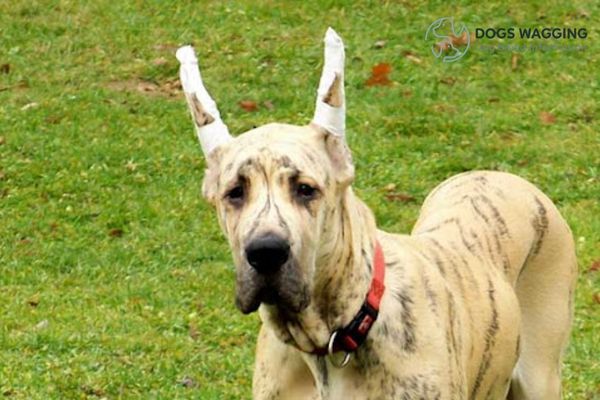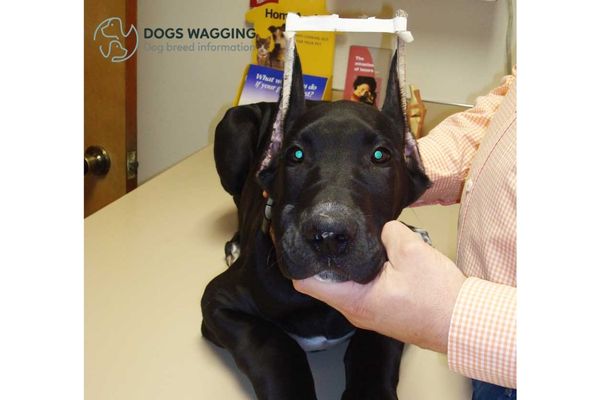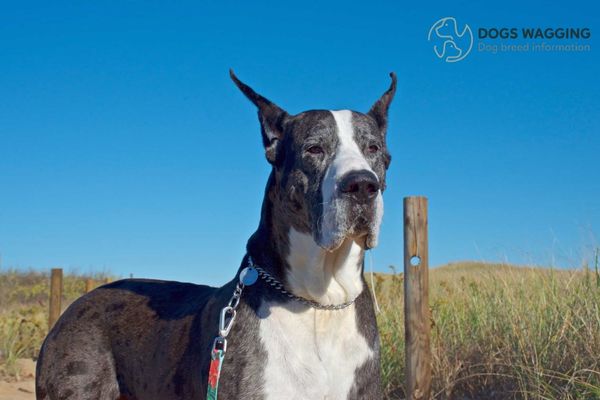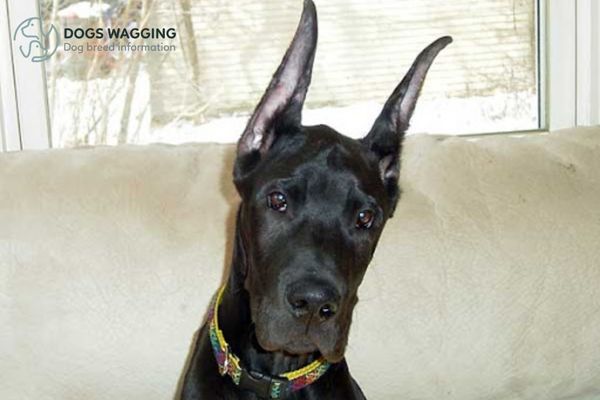John Switch • Fri Mar 01 2024
Ear Crop Great Dane: All Fun Facts You Should Know

Now, we are discussing Ear Crop Great Dane!
Great Danes are majestic creatures and are famous for their imposing size and gentle nature. A practice that has been related to this breed is ear cropping.
Here's essential information regarding Great Dane ear cropping, covering its historical background, the procedure itself, and the necessary post-surgery care for your puppy. Details on various crop styles and wrapping techniques are also provided for your reference.
> READ MORE:
- Corgi Great Dane Mix: A Complete Guide
- Mini Great Dane: A Complete Guide for You
What Is Great Dane Ear Cropping?
Ear cropping is a surgical procedure to alter the natural shape and carriage of a Great Dane's ears to make them stand erect. It is typically performed for aesthetic reasons or to conform to specific breed standards in competitive dog shows. The process involves removing part of the ear flap and then shaping the remaining ear to stand upright.
Does Ear Cropping Hurt Your Great Dane?
It's crucial to recognize that ear cropping for Great Danes is a surgical process that entails anesthesia, incisions, bleeding, sutures, and a subsequent healing phase.
While this procedure is generally well-tolerated by most puppies, mainly when conducted by a skilled veterinarian who provides pain relief and proper post-operative care, it's essential to acknowledge that without these measures, ear cropping would be both inhumane and distressing.
We've noted that numerous veterinarians today choose not to perform ear cropping. Yet, it's common for show breeders to have affiliations with practitioners who may or may not adhere to ethical standards in their approach to ear cropping.
Why Do People Crop Great Dane Ears?
Below are some reasons why crop Great Dane ears.
Historical Reason
Ear cropping has roots in ancient practices, mainly observed in Great Danes when the breed was primarily utilized for hunting wild boars in Europe.
Hunting boars posed significant challenges and risks, as these creatures are famous for their ferocity. As more dogs suffered severe injuries from bites, cuts, or tears inflicted by the boars' sharp teeth and tusks, a solution was sought.
Some people believe that removing a portion of the ear would help prevent such injuries during boar hunts.
Additionally, humans historically cropped Great Dane ears under the belief that it could mitigate specific health issues, such as ear infections. Although not substantiated by scientific studies, some proponents argue that dogs with shorter ears experience fewer ear infections.
The theory suggests that when a Great Dane's ear drops over the ear canal, moisture can become trapped inside, fostering bacterial growth and increasing the likelihood of infection. In contrast, when the ears are upright, moisture is more effectively wicked away through evaporation. Consequently, many individuals choose to have their Great Danes' ears cropped to minimize the risk of infections.
Modern Reason
The desire to achieve a particular aesthetic greatly influences whether a Great Dane owner opts to crop their puppy's ears.
In modern times, ear cropping no longer serves its original purpose of protection during hunting or in the context of breeding fighting dogs, a practice that is hopefully now obsolete. As such, ear cropping has become primarily a matter of personal preference.
Some certain breeds, like Great Danes, Dobermans, Schnauzers, and Pitbulls, have been distinguished by their distinctive head and ear shapes.
Many individuals appreciate the visual appeal of shorter ears on a Great Dane, with some choosing to crop their dog's ears to convey a more aggressive or athletic appearance.
This viewpoint enjoys widespread popularity, as evidenced by the approximately 130,000 puppies in the United States that undergo ear cropping each year.
When Is the Ear Crop Great Dane Complete?
When it comes to Ear Crop Great Dane, timing is critical. It's best to undertake the procedure sooner rather than later. For optimal results, ear cropping should ideally occur between 7 and 10 weeks of age.
Once a puppy surpasses 12 weeks, it becomes increasingly challenging to perform the procedure. It becomes more painful for the dog at this stage, and there is a risk of lasting psychological trauma. Therefore, early intervention is essential to ensure a smoother and less distressing experience for the puppy.
How Is Ear Crop Great Dane Done?
In simple terms, ear cropping involves surgically shaping a dog's ears.
Licensed veterinarians perform this procedure on puppies of appropriate age. Under general anesthesia, the veterinarian removes over half of each ear to achieve the desired shape.
Following the surgery, the ears are either wrapped with gauze or secured with foam and glue to encourage them to stand erect.

Approximately ten days later, the veterinarian removes the stitches and tapes the puppy's ears upright before clearing them to go home.
Acknowledging the risks associated with anesthesia, as with any surgical procedure, is essential.
Additionally, there's no guarantee regarding the outcome of the cropping in terms of size, style, or quality, as healing varies among puppies, and the skill level of veterinarians differs.
After Surgery Care for Ear Crop Great Dane
If you decide to proceed with ear cropping for your Great Dane, it's crucial to provide diligent after-surgery care for your puppy:
- Adhere strictly to the veterinarian's instructions and guidelines. Deviating from these instructions could result in disfigured ears, infection, or other complications.
- Change your puppy's dressings as directed by the veterinarian, and administer any prescribed medications carefully.
- Ensure regular and thorough cleaning of your puppy's ears following the surgery.
- Prevent your puppy from scratching or biting its cropped ears, as discomfort may lead to such behavior.
- Clean the incisions on your puppy's ears regularly using a recommended disinfectant, such as ear wash peroxide.
- If scabs form on the incisions, apply a warm washcloth for approximately five minutes to soften the clotted blood and aid in scab removal. Be cautious not to allow bandages to become wet during cleaning, as this may lead to infection.
- Following ear cleaning, apply antibiotic cream to the incisions as your veterinarian advises to prevent infections.
- Monitor your puppy's ears for signs of infection, such as swelling or redness. Promptly consult your veterinarian if you observe any abnormalities. This is because ear infections can pose severe risks to your Great Dane's health.
Your veterinarian may provide additional specific guidelines. It's essential to follow their instructions meticulously to ensure proper healing of your cropped ear Great Dane.
Ethics of Ear Crop Great Dane
Many, including certain veterinarians, assert that the continued practice of ear cropping is unethical. With no substantial medical rationale, personal preference or tradition is a reason for the appearance and popularity of ear cropping.
Critics argue that such reasons do not justify subjecting an animal to the pain and trauma of having its ears surgically altered.
The ethical dimension of animal welfare arises as cropping a puppy's ears offers no tangible benefit to the dog. Some veterinarians even refuse to perform the procedure, prioritizing the well-being of the animal.
While ear cropping remains unregulated in the United States, some countries like Australia, Canada, and most of Europe prohibit this procedure.
Ear Crop Great Dane Styles
Ear Crop Great Dane encompasses numerous variations, yet they generally fit into three primary categories: the show crop, the pet crop, and the short crop.
Great Dane Show Crop
The pet crop exudes elegance and beauty, imparting the impression of longer, taller ears. To achieve the desired upright stance, meticulous wrapping and posting of the ears are essential.
However, this style typically carries a higher risk of the ears not standing as desired. It involves a prolonged and intensive process demanding considerable dedication and nurturing care.
Pet Crop
The pet crop is often the most prevalent and widely depicted style. It imparts a neat and polished appearance to the puppy, which is relatively easy to maintain compared to the show crop.
Typically, most Great Danes need several months of posting before their ears can stand independently.
Short Crop
In this style, most of the ear flap is surgically removed. It results in a final cropped ear that is short and robust. This style is popular in working dogs.
Ear Crop Great Dane Cost
The expenses associated with ear cropping can vary significantly. It depends on your location and the expertise of the veterinarian conducting the procedure. Typically, if you opt for ear cropping independently, anticipate costs ranging from $250 to $1200.
Seeking out a veterinarian who specializes in ear cropping is advantageous, as they often possess a wealth of resources and a portfolio showcasing their work.
Breeders who arrange for entire litters to undergo cropping on the same day often benefit from bulk discounts, with the cost of cropping factored into the puppy's overall price. This streamlined approach is frequently the most straightforward and cost-effective method for obtaining a Great Dane puppy with cropped ears.
Conclusion
Ultimately, Ear Crop Great Dane is a decision that rests with you.
Once you've weighed the risks and made your decision, it's crucial to ensure that you can provide your Great Dane with the care and attention it requires throughout the healing journey.
Regardless of whether you choose to keep your puppy's ears natural or opt for cropping, your furry companion will always be a source of beauty and boundless joy in your life.

John Switch / Author
Hello this is a test author
Recent blog posts

John Switch • Thu Feb 22 2024
Akita Mix With Rottweiler: All Facts You Should Know
The Akita Mix With Rottweiler is a combination of purebred Akita and purebred Rottweiler. These dogs are very loyal, devoted, and intelligent. They require

John Switch • Fri Dec 29 2023
American Corgi: All Facts You Need to Know
An American Corgi are a mixed dog which is result of crossing two different breeds: the Cardigan and the Pembroke Welsh. Let's explore the allure of the Am

John Switch • Fri Feb 23 2024
All Things About Anatolian Shepherd: Traits, Health Cares
Do you want to know more about Anatolian Shepherd Dogs? They originated in Turkey, where they were bred to be protectors of shepherds' livestock. They are a

John Switch • Tue Feb 27 2024
Australian Cattle Dog Behavior Issues You Should Know
What are Australian Cattle Dog Behavior Issues? - Australian Cattle Dogs are famous for behavioral issues, such as destructive behavior, nuisance barking, d
 Great Dane Dog Ear Cropping
Great Dane Dog Ear Cropping Ear Crop Great Dane
Ear Crop Great Dane The Show Crop styles
The Show Crop styles The Pet Crop style
The Pet Crop style